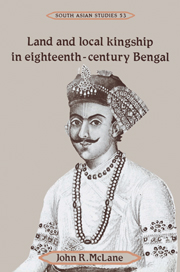Book contents
- Frontmatter
- Contents
- List of tables
- Preface and acknowledgments
- List of abbreviations
- Select glossary
- Map of southwest Bengal
- Part I Bengal
- 1 Introduction
- 2 Nazims of Bengal and the large zamindars
- 3 Collecting rents and revenues
- 4 Coercion
- 5 Political gifts and patronage
- Part II Burdwan
- Bibliography
- Index
- Cambridge South Asian Studies
2 - Nazims of Bengal and the large zamindars
from Part I - Bengal
Published online by Cambridge University Press: 13 October 2009
- Frontmatter
- Contents
- List of tables
- Preface and acknowledgments
- List of abbreviations
- Select glossary
- Map of southwest Bengal
- Part I Bengal
- 1 Introduction
- 2 Nazims of Bengal and the large zamindars
- 3 Collecting rents and revenues
- 4 Coercion
- 5 Political gifts and patronage
- Part II Burdwan
- Bibliography
- Index
- Cambridge South Asian Studies
Summary
The distinctive feature of political life in eighteenth-century rural Bengal was the continuous domination of the revenue-collecting system by a small number of very large landholders. At the close of nawabi rule, fifteen landholders paid 60 percent of the province's revenue; three decades earlier and three decades later, the distribution was similar. To the steeply graded hierarchy of intermediaries and cultivators below, these landholders were rajas who gathered rents, dispensed patronage and entitlements, and upheld the ritual-moral order; to the government at Murshidabad above, they were zamindars who were the principal agency of local revenue extraction. The larger raja-zamindars controlled hundreds of villages and upwards of 1,000 square miles. This extreme concentration of territory in the hands of a small number of rajas dates from the administration of Murshid Quli Khan who led the Mughal provincial administration, apart from a three-year interruption, from late 1700 until his death in 1727. In this period, Bengal became virtually independent of the Mughal emperor, and the subahdari or governorship became hereditary, for the first time, in the family of Murshid Quli.
This chapter examines the higher or nawabi administrative-polical milieu in which the zamindars lived before 1750. The first chapter commented on the rise in the late Mughal period of new groups who took advantage of expanding commercial and political opportunities and who formed the base of support for newly autonomous regions. The expansive zamindars in Bengal were one such group.
- Type
- Chapter
- Information
- Land and Local Kingship in Eighteenth-Century Bengal , pp. 27 - 44Publisher: Cambridge University PressPrint publication year: 1993



